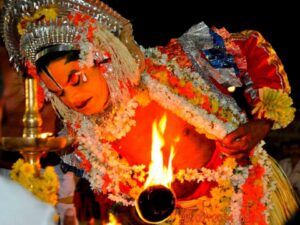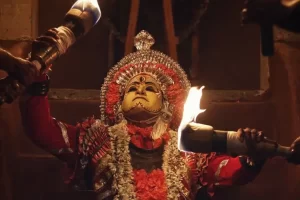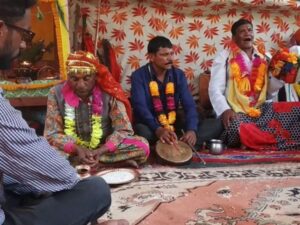
Since ancient times, religious rituals and cultural traditions have been a significant platform under the spotlight in tracing out the past within which spirit worship is prominent among the other forms of worship. In this context, spiritual worship in two states Karnataka and Uttarakhand from Southern part as well as north respectively are mainly prominent among the natives.
Bootha Kola or kola aata where bootha means ‘spirit dance form’ is a demi-gods’ worship or daivas and bhootas (supernatural spirits) worship which is a part of ancient ritual in Tulu speaking community, Kannada district Karnataka celebrated every year from December to January. It dates back to 700-800 BCE coinciding with the immigration of early Tulu Tribes which introduced initial cults of Bermer and Panjurli. These demi-gods are said to be the guardians of the village protecting the territories from evil deeds and sometimes linked with attendants of Lord Shiva showing expressions of devotion, inspiration and entertainment.

Jumadi, Jarandaya, Panjurli and other daivas are kept in idol form in Daivasana where saana, a local term which means shrine of the holy spirit where the entries are only restricted to men and little girls. It is believed that Daivas are the utmost one to fulfill the prayers but at the sametime if not cared and respected, their wrath is meant to be very dangerous if they get hurted.
These Kola are generally performed by trained individuals who basically belong to the lower caste of the society. The procedure of dance and pooja starts by beating drums and playing music and it is also believed that for some duration real spirit comes into the person and they start to predict the future.
Similar to Kola, practicing in the deep south, Uttarakhand in the North also has spiritual worship called Jagar. Jagar is a ritualized style of worshiping 33 koti Devi Devta which is the main and auspicious tradition among the people of Kumaon and Garhwal in the state of Uttarakhand. It is based on the concept of divine justice and basically linked with the awakening of gods, local deities and ancestors to seek blessings.

Jagar word has Sanskrit root where Jaga means ‘to awaken’. The spirit is awakened through the means of music which are mainly the ballads from Mahabharata and Ramayana sung by Jagariya. Another important participant being the Dangariya where Dangar is a kumaon word meaning ‘the way’ whose body is used as a medium by the gods and last being the Syonkar who organized the jagar to seek divine intervention to his problem and his home is the place where the jagar is held. It is assumed that these kinds of paranormal beliefs and plethora of folk gods are due to the hard times faced by the people of Himalayas and it was the isolation which promoted the emergence of local religious traditions.
Every village has its own god or bhumyal or kshetrapal who protects the territorial boundaries and each family has its own kul devta or kul devi and this is this kuldevta tradition which maintains a strong linkage with concept of hinduism that provide it a base to flourish in India and Nepal.The rites performed in the jagar are categorized into three: dev jagar or local deity occupying body medium; bhoot jagar or spirit worship where ancestors’ souls are called and masan pujas.
The Kola of the south and Jagar in the Northern India are interlinked to each other through various similarities they show. First, FIRE which is denoted as sacred. In kola as well as jagar, the performer dances around and on the fire. Second, reference to Lord shiva. In kola, there is use of trishula and performers are sometimes painted in blue whereas in Jagar there is use of musical instruments such as Damru (prominent one) and other could be ghost worshiping which is linked to shiva as he is said to be the king of cremation. Third, in both cases is the seeking of blessings as well as predicting the future.
Although the two regions are distant and miles away from each other, the cultural influence and similarities in the traditions and practices could be the consequence of sanskritization and traveling and dissemination of cultural practices and traditions from one part to the another.

